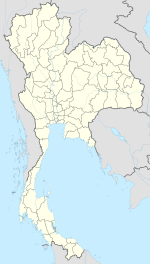Mae Chai
Mae Chai
แม่ใจ | |
|---|---|
| Coordinates: 19°21′N 99°50′E / 19.350°N 99.833°E | |
| Country | |
| Province | Phayao |
| Amphoe | Mae Chai |
| Population (2005) | |
| • Total | 5,094 |
| Time zone | UTC+7 (Thailand) |
Mae Chai (Thai: แม่ใจ) is a small town and subdistrict (tambon) in Mae Chai District, in Phayao Province, Thailand. It is the principal town in the district; the town is also split with the tambon of Si Thoi. As of 2005, it has a total population of 5,094 people. It is located in the north-western part of the province not far from the border with Lampang Province. It lies along the National Road 1 (Phahon Yothin Road),[1] and is connected by road to Phayao in the south.[2] To the north along the highway are Pa Faek and then Mae Yen across into Chiang Rai Province. The tambon has 10 villages under its jurisdiction. It lies partly within Mae Puem National Park. Mae Chai River is also a river running in the area.
Economy
In the 1950s, the area was reported to be heavily forested but it saw an extraordinary growth in rice production in the 1990s.[3] The tambon also has great conditions with temperature and rainfall for highland wheat production, which has been exploited in villages such as Pha Daeng with improved technology.[4] Red kidney beans are also grown in the area.[5]
References
- ^ Kānsư̄sān hǣng Prathēt Thai (1999). Annual report. Communications Authority of Thailand. p. 77. Retrieved 23 January 2012.
- ^ Maps (Map). Google Maps.
- ^ Forsyth, Tim; Walker, Andrew (2008). Forest guardians, forest destroyers: the politics of environmental knowledge in northern Thailand. University of Washington Press. p. 132. ISBN 978-0-295-98792-7. Retrieved 23 January 2012.
- ^ John E. Woolston, International Maize and Wheat Improvement Center (1993). Wheat, barley, and triticale cultivars: a list of publications in which national cereal breeders have noted the cooperation of germplasm they received from CIMMYT. CIMMYT. p. 60. ISBN 978-968-6923-01-8. Retrieved 23 January 2012.
- ^ McKinnon, John (1989). Hill tribes today: problems in change. White Lotus. p. 491. ISBN 978-974-8495-25-5. Retrieved 23 January 2012.

